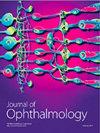斜视等眼科疾病患儿的点视力筛查测试-复测
IF 1.9
4区 医学
Q3 OPHTHALMOLOGY
引用次数: 0
摘要
背景。点视力筛查仪(SVS)已被广泛用于婴幼儿的眼健康检查。本研究旨在评估两种 SVS 测量方法在眼科疾病患儿中的重现性。研究方法本研究选取了 29 名 15 岁或 15 岁以下到我院接受屈光检查的患者,在滴用 2 滴 1%环戊托品眼药水之前和之后至少 60 分钟(在环状麻痹之前和之后)用 SVS 进行测量。分别在环形麻痹前后进行了两次 SVS 测量。对环麻痹前后的球面、球面等值(SE)、圆柱、J0 和 J45 值的类内相关系数(ICC)和 Bland-Altman 分析进行了分析。结果。29 名患者的平均年龄为 7.6±2.4 岁。其中男性 11 人,女性 18 人。第一次测量和第二次测量的平均球面视力值分别为 0.60 ± 1.74 D 和 1.42 ± 2.27 D,而第一次测量和第二次测量的平均球面视力值分别为 0.42 ± 1.67 D 和 1.47 ± 2.23 D。第一次测量和第二次测量的圆柱值分别为-1.58 ± 1.13 D 和-1.66 ± 0.91 D。第一次和第二次测量球面、SE、圆柱、J0 和 J45 值的 ICC 分别为 0.95、0.98、0.83、0.86 和 0.86。环形瞳孔术后第一和第二个球面、SE、圆柱、J0 和 J45 值的 ICC 分别为 0.99、0.99、0,87、0.73 和 0.80。对屈光手术前的第一和第二球面和 SE 值进行的 Bland-Altman 分析显示,随着远视度数的增加,其变化呈扇形。结论。连续两次 SVS 屈光度测量的球镜和 SE 值具有较高的可重复性,但柱镜、J0 和 J45 值的可重复性较低。从这些结果来看,需要多次测量才能获得可靠的圆柱度值结果。本文章由计算机程序翻译,如有差异,请以英文原文为准。
Test-Retest of the Spot Vision Screener among Children with Ophthalmological Diseases including Strabismus
Background. The spot vision screener (SVS) has been widely used for eye health examinations of infants and young children. The purpose of this study was to evaluate the reproducibility of two SVS measurements in children with ophthalmological diseases. Methods. 29 patients aged 15 years or younger who visited our hospital for refraction examinations with SVS before and at least 60 minutes after administration of 2 drops of 1% cyclopentolate ophthalmic solution (before and after cycloplegia) were included in this study. Two SVS measurements were made before and after cycloplegia, respectively. Intraclass correlation coefficients (ICCs) and Bland–Altman analysis for spherical, spherical equivalent (SE), cylindrical, J0, and J45 values before and after cycloplegia were analyzed. Results. The mean age ± standard deviation (SD) of the 29 patients was 7.6 ± 2.4 years. There were 11 males and 18 females. The mean spherical values based on the SVS before and after cycloplegia were 0.42 ± 1.67 diopter (D), and 1.47 ± 2.23 D for the first measurement and 0.60 ± 1.74 D, and 1.42 ± 2.27 D for the second measurement, respectively. The mean cylindrical values based on SVS before and after cycloplegia were −1.45 ± 0.96 D and −1.65 ± 0.89 D for the first measurement and −1.58 ± 1.13 D and −1.66 ± 0.91 D for the second measurement, respectively. The ICCs for the first and second spherical, SE, cylindrical, J0, and J45 values before cycloplegia were 0.95, 0.98, 0.83, 0.86, and 0.86, respectively. The ICCs for the first and second spherical, SE, cylindrical, J0, and J45 values after cycloplegia were 0.99, 0.99, 0,87, 0.73, and 0.80, respectively. The Bland–Altman analysis of the first and second spherical and SE values before cycloplegia showed fan-shaped variation as hyperopia increased. Conclusions. Two consecutive SVS refraction measurements have a high degree of reproducibility for spherical and SE values but a low degree for cylindrical, J0, and J45 values. From these results, multiple measurements are required to obtain reliable results for cylindrical values.
求助全文
通过发布文献求助,成功后即可免费获取论文全文。
去求助
来源期刊

Journal of Ophthalmology
MEDICINE, RESEARCH & EXPERIMENTAL-OPHTHALMOLOGY
CiteScore
4.30
自引率
5.30%
发文量
194
审稿时长
6-12 weeks
期刊介绍:
Journal of Ophthalmology is a peer-reviewed, Open Access journal that publishes original research articles, review articles, and clinical studies related to the anatomy, physiology and diseases of the eye. Submissions should focus on new diagnostic and surgical techniques, instrument and therapy updates, as well as clinical trials and research findings.
 求助内容:
求助内容: 应助结果提醒方式:
应助结果提醒方式:


